
Original Link: https://www.anandtech.com/show/333
Super7 Video Accelerator Comparison - Part 2: Mid-Range Gaming Solutions (June 99)
by Anand Lal Shimpi on July 2, 1999 12:51 AM EST- Posted in
- GPUs
As with all other computer users, Super7 owners can be classified into two distinct categories from a gaming perspective, high-end gamers and mid-range gamers. The reason for leaving out the classification low-end is simple, the slowest 3DNow! Super7 processor is the K6-2 300, which hardly meets the low-end classification that is pretty much reserved to K6 200 and K6 233 users. Therefore the next logical step in the performance comparison would be the more commonplace mid-range Super7 systems.
While Part 1 of AnandTech’s coverage was reserved for the bleeding edge of video cards for the fastest Super7 systems, Part 2 will tailor to the majority of the Super7 population covering all previous and current generation video cards on mid-range as well as high-end systems. The Super7 market was initially intended for use as a "value" alternative to Intel based systems, however since the release of the K6-3 the term Super7 hasn’t been reserved only for low-end systems. Unfortunately a limiting factor, until recently, has been poor attention to driver support for Super7 systems as discussed in Part 1 of this article. Part 1 addressed quite a few important topics that are worth reading over before proceeding to the next step in this progression.
Armed with the results from the first article and a few new test configurations, let’s proceed to the second part, Mid-Range Gaming performance.
Graphics Clock vs CPU Clock
One of the most obvious deductions you can make from the results of the high end testing is that the graphics clock (core speed) started to become an influential factor as the resolution increased beyond 1024 x 768. Although the same is true once you drop the CPU speed, the performance boost achieved from an increased graphics clock is not as great. With the limiting factor being the CPU, overclocking your graphics card on a slower system won’t yield nearly as great of a performance increase as doing the same on a higher end system would.
Z-Buffering: Trick or no Trick?
There is much debate as to whether or not 16-bit Z-Buffering, in combination with 32-bit color rendering, is used as a performance illusion by manufacturers to decrease the noticeable performance drop when moving from 16 to 32-bit color. The "trick" first truly came into the eyes of the public and the media with the release of the first ATI Rage 128 reviews which all pretty much indicated the same conclusion, a very small performance drop when going from 16-bit to 32-bit color.
Upon further inspection, the fact that the drivers were using a 16-bit Z-Buffer with 32-bit color instead of a 32-bit Z-Buffer made a few people do a double take. After 32-bit Z-Buffering support was enabled, the performance drop did grow to be something more than the virtually non-existent drop that was experienced with the first set of drivers for the card. Theoretically, a manufacturer could disable 32-bit Z-Buffering to achieve a greater impact in a review when their particular card exhibits a very small or nonexistent drop in performance when moving from 16 to 32-bit color. Not to say that any current manufacturers would dream of doing such a thing, but it is always a possibility. Now that more people look for the Z depth before dropping their jaw at performance numbers the "trick," assuming that it is one, isn’t as effective as it once was/might have been. This brings us to the next question, does it really matter?
It always seems like everyone is quick to attack yet very few are willing to understand why they’re attacking, or for what goals. So what does 32-bit Z-Buffering buy you? The closest parallel one can make to the argument of whether or not 32-bit Z is important when rendering in 32-bit color (in games) is the classic 16-bit vs 32-bit color debate. Some can notice the difference and it bothers them tremendously, others either can’t, or don’t care. Which brings us to the next argument…
With mid-range to lower-end systems, the decision of performance vs image quality will come into play and most likely face you as a decision you’ll have to make. It seems like the release of Quake3 test has rendered, at least in the minds of the hardcore gamers, the once popular Voodoo2 an unattractive solution. For Super7 users, especially with slower CPUs, the Voodoo2 is still a very viable option as it is cheaper than most of the newer alternatives, and it performs quite well.
When the K6-2 was first released, the Voodoo2 was the card to get, unfortunately the $200+ pricetag of a single 12MB Voodoo2 board kept most users from shelling out the cash to buy two boards and run them in the ever so popular SLI mode. Luckily, times have changed, and if you have held on to that single 12MB Voodoo2 board then your best upgrade, from a purely performance minded standpoint, would be to simply pick up a second Voodoo2 board. The problem with the Voodoo2 and Voodoo2 SLI configurations is the resolution limitations set by the on-board memory, 800 x 600 for the Voodoo2 (with Z-buffering enabled) and 1024 x 768 for the Voodoo2 SLI. While 800 x 600 may be a bit tame for most gamers, 1024 x 768 is just perfect, and happens to be one of the most popular resolutions for gamers to run in with similar hardware configurations such as the one being described.
The performance of a Voodoo2 SLI solution on a mid-range Super7 system is just slightly slower than that of a Voodoo3 2000. If you remember that a Voodoo3 2000 is very little more than an overclocked, single card, Voodoo2 SLI, then the results make sense. You need to sit down and ask yourself what is more important to you, performance, or image quality. The argument can go back and forth between firm believers in either facet however the final decision is up to you, and it’s for you to make.
In the first article the stability of some driver solutions offered wasn’t made as clear as it could have been. In life, there are always things we dread doing, whether it is cleaning the kitchen sink, washing the dog, or making your bed. Similarly, when running hundreds of tests with drivers that constantly crash after one or two resolution switches, you quickly begin to add that experience to your list of pet peeves. What names made it to AnandTech’s list over the thousands of tests AnandTech ran for this comparison?
At the top of the list was NVIDIA, although there are many unreleased driver revisions floating around the net, and many hacks that were put together to solve specific problems, NVIDIA’s officially released reference Detonator 1.88 drivers caused, by far, the most problems during the tests. One could go as far as to say that the Detonator 1.88 drivers are entirely too buggy and unstable for use in a normal Super7 system, outside of AnandTech’s test beds whose sole purpose is to take quite a beating without complaining. With the amount of unofficial driver releases that have popped up all over the net, it shouldn’t be long before NVIDIA addresses the issues AnandTech experienced with the drivers. Until then, you’re probably better off using the drivers provided by the manufacturer of your card, you won’t have the fastest performance but at least you’ll be able to use your system reliably.
For entirely too many of the tested cards, 1600 x 1200 x 32-bit color was a difficult setting to achieve reliably in 3D gaming operation. Outside of 3DLabs’ Permedia3, there were virtually no occasions upon which such a high resolution could be obtained without resulting in some sort of instability for extended periods of time.
Speaking of 3DLabs, contrary to what one would assume, the Permedia3 experienced quite a few problems related to driver issues on Super7 platforms. Incorrectly displayed textures and visual artifacts were prominent during the OpenGL tests which could be related to the Permedia3’s unique Virtual Texture management that is automatically enabled for OpenGL applications. Luckily the Permedia3 ended up being one of the most stable, if not the most stable, performer out of the 10 cards AnandTech tested in Part 2 of the Super7 Video Accelerator Comparison. Surprisingly enough, 3DLabs was aided by S3 and Matrox in the sense of upholding a level of stability during the tests.
3dfx’s MiniGL drivers worked flawlessly during all the tests, as we’ve come to expect from the drivers that have been in use for such a long period of time. Unfortunately, the same can’t be said about their currently available beta OpenGL ICD (Quake3 compatible) drivers. The Voodoo2’s release candidate drivers are much more stable than what was out previously for the Voodoo2 in terms of OpenGL compliant releases, however there is still a bit of stability and definitely performance tweaking necessary before most users drop their MiniGL drivers. The Voodoo3’s OpenGL ICD drivers weren’t too pleasing either, however they weren’t as flaky as the Detonator 1.88 drivers.
Among the newcomers, ATI and Matrox shared unusually reliable drivers for a Super7 platform. This is unusual considering that ATI had previously not featured the best Super7 drivers, luckily things have changed since then and the Rage 128 is a definite option for Super7 users once again.
In the original tests, the S3 Savage4 PRO+ performed well below par, not a good sign at all considering even the older TNTs were giving it a run for its money with the frame rates it was cranking out. S3’s history with the Savage3D and Savage4 has always been that performance improvements are commonly seen with updated drivers, and after the help of quite a few AnandTech readers (thanks guys) AnandTech soon had another Savage4 test system running with updated drivers. The results?
The Savage4’s performance is much more improved than in the first article, and in order to be fair to S3, all benchmarks were run over again with the new drivers. Unfortunately these drivers are not available on S3’s website, instead you’ll have to do a little surfing to grab these, but the performance is worth it.
Defining a Mid-Range Gaming Solution
With that settled, we are brought to the next issue at hand, what defines a mid-range gaming solution. A high-end solution is easy to pick, just grab the fastest processors out there and stick them on a motherboard. With mid-range, you have to estimate what the majority of the population will be using.
At the release of the K6-2, the only chips available for purchase were the K6-2 300s and the rare K6-2 266s. The release of the 333MHz K6-2 did not inspire everyone to go out and buy 333MHz K6-2s simply because the 95MHz FSB requirement of the chip didn’t offer the performance advantage over the 100MHz FSB of the K6-2 300, causing the overall speed of the processor to be little more than what everyone could already buy at a lesser cost with the 300. Therefore the K6-2 300 was an ideal choice for a mid-range system since it is a popular CPU, however what about faster mid-range systems?
The K6-2 400 was the first processor to use the improved CXT core, and also drew quite a bit of attention as it was released during a time when the Pentium II 450 was the fastest desktop Intel CPU available and also the most pricey. This gave AMD yet another popular buy, as the K6-2 400 eventually dropped in price to a very affordable level, making the second CPU for the mid-range test bed the popular K6-2 400.
Using the same Epox MVP3G-M from the first article, and the same system configuration, let’s get to the setup for the test.
The Test
AnandTech's Super7 test bed was configured as follows:
- AMD K6-2 475 running at 95MHz x 5.0 at 2.4v core on an Epox MVP3G-M (1MB)
- AMD K6-2 400 running at 100MHz x 4.0 at 2.4v core on an Epox MVP3G-M (1MB)
- AMD K6-2 300 running at 100MHz x 3.0 at 2.4v core on an Epox MVP3G-M (1MB)
- AMD K6-3 450 running at 100MHz x 4.5 at 2.4v core on an Epox MVP3G-M (1MB)
Both processors were cooled using Cooler Master fans provided by Boston Limited
- 128MB Mushkin Samsung Original PC100 SDRAM
- Western Digital Caviar 5.1GB EIDE HDD
- 48X Phillips EIDE CDROM Drive provided by Boston Limited
- Windows 98 SE + DirectX 6.1a
- Quake 2 using demo1.dm2 and 3Finger's crusher.dm2 demos
- Expendable using -timedemo option
The Cards
- 3dfx Voodoo3 2000 clocked at 143/143MHz (core/mem)
- 3dfx Voodoo3 3000 clocked at 166/166 & 175/175MHz (core/mem)
- 3dfx Voodoo2 SLI (24MB) clocked at 90/90MHz (core/mem)
- 3dfx Voodoo2 (12MB) clocked at 90/90MHz (core/mem)
- 3DLabs Permedia3 clocked at 110/110MHz (core/mem)
- ATI Rage 128 (32MB) clocked at 105/105MHz (core/mem)
- Diamond Stealth III S540 Savage4 clocked at 125/143MHz (core/mem)
- Hercules Dynamite TNT2 Ultra clocked at 125/150, 150/175, & 175/200MHz (core/mem)
- Matrox Millennium G200 clocked at 86/115MHz (core/mem)
- Matrox Millennium G400 clocked at 125/166MHz (core/mem)
- Matrox Millennium G400MAX clocked at 166/200MHz (core/mem)
The Drivers
- AMD 3DNow! Quake2 patch version 3.20
- 3dfx Voodoo2 drivers version 3.03.00
- 3dfx Voodoo2 OpenGL ICD version 1.0.0.0439 ICD
- 3dfx Voodoo3 MiniGL version 1.48
- 3dfx Voodoo3 OpenGL ICD version 1.01.02
- ATI Rage 128 drivers version 6.11-HPD1K-OGL1225
- NVIDIA TNT Detonator drivers version 1.88
- NVIDIA TNT2 Detonator drivers version 1.88
- Matrox G200 PowerDesk drivers version 5.13.020
- Matrox G400 PowerDesk drivers version 5.11.012
- S3 Savage4 drivers version 4.11.01.8006-8.09.07
With the addition of some of the older players to the high end gaming solution test bed from part 1 of this series, the options grew considerably. The 1600 x 1200 resolution still proved to be the high-end territory, however the resolution to watch is 1024 x 768, so let's see how the older competitors stacked up.


The good ol' Voodoo2 SLI combo is still packing quite a powerful punch at 1024 x 768, even with 3dfx's OpenGL ICD. The latest ICD drivers from 3dfx prove to be higher performing, more stable, and better overall than even the Voodoo3's ICD. The improved Savage4 drivers place it above the old Rage 128 and TNT, with the Matrox G200, using its recently released final OpenGL ICD taking up the back with the slowest overall performance. Keep in mind that although the G200 is the slowest out of this pack, it does compete among the best in terms of image quality. Let's see what happens at lower resolutions...

At lower resolutions, 3dfx still dominates as was concluded in the first part of this series, however the Savage4 picks up the pace and rises above the single Voodoo2 that once blessed a number of systems as the card to buy. With more driver optimizations, the performance of the Savage4 can hopefully improve as these new scores prove quite well.


The same story sticks with the K6-2 475, the addition of the older cards brings a few more players into the field of vision that will govern your final decision. Keep a close look at the performers at 1024 x 768, the target resolution for this generation of graphics cards. Super7 users should be allowed to enjoy that resolution just as much as Slot-1/Socket-370 users do.




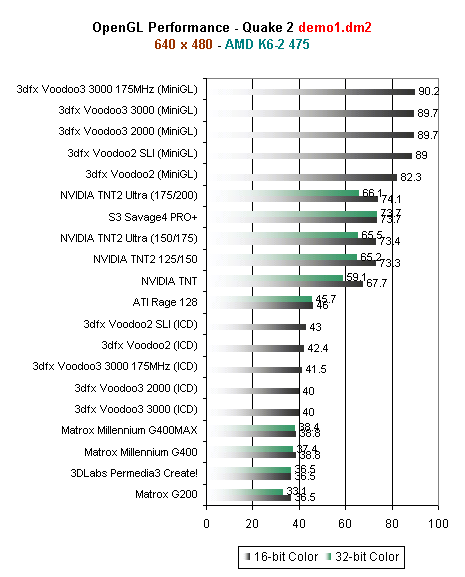
Here's where things get interesting, pull away the power of the faster Super7 CPUs and see how well the bad boys really dominate. First, the 1600 x 1200 tests just for kicks.

At 1152 x 864, 3dfx does take a noticeable, albeit not massive lead over NVIDIA with both the overclocked Voodoo3 3000 and the regular 3000. The Hercules TNT2 Ultra is close behind, but keep in mind that the 175MHz clock of that particular chip is much higher than the standard TNT2 Ultra speed, whose 150MHz clock isn't enough to push the Voodoo3 2000 aside, although it comes quite close.
Now if you take 3dfx's precious MiniGL away, and arm the Voodoo3 with its OpenGL ICD, NVIDIA dominates with even the regular 125MHz TNT2 outpacing the overclocked Voodoo3. The Savage4 doesn't perform as well on the K6-2 400 as it is slightly outpaced by the ATI Rage 128, however it still manages to keep a small lead over the old TNT. At this point, the Rage 128, Savage4, TNT, and Permedia3 all perform basically alike. The only exception to the bottom of the list being the Matrox G200 which is noticeably slower than the rest of the bunch. Fortunately for Matrox, the G400MAX rests comfortably beneath the Voodoo3 3000 (ICD) in terms of performance on this particular test.
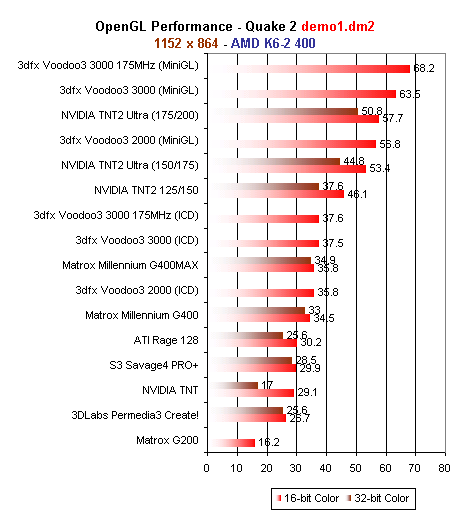
The stats don't change all too much here, however the addition of the Voodoo2 SLI makes things a bit interesting. For a user upgrading from a single Voodoo2, an often times overlooked upgrade path is another Voodoo2, and this graph is proof of the benefits. Outpacing the TNT2 Ultra, the Voodoo2 SLI is still a very viable solution, and a cost effective one at that, provided that you already have a Voodoo2 card. Once all 12MB V2 cards drop to below the $60 mark, the Voodoo2 SLI setup will probably become one of the more desired solutions for this particular market. If you want the absolute best performance however, look at the graphs and decide for yourself.
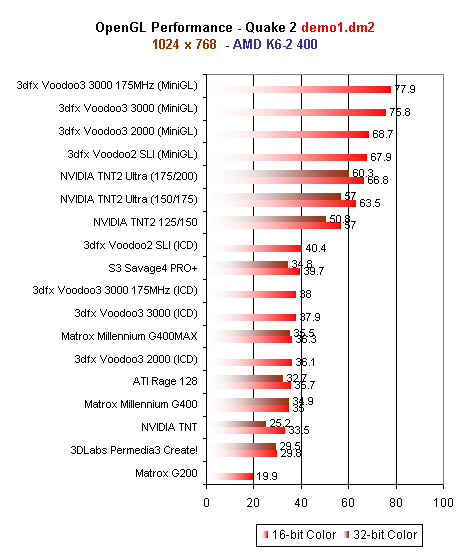
As the resolution drops the Savage4 holds its head a bit higher than the single Voodoo2 once again, however it still falls a few frames short of reaching the 125MHz TNT2. An overclocked Savage4, on the other hand, may have what it takes to bridge that gap.
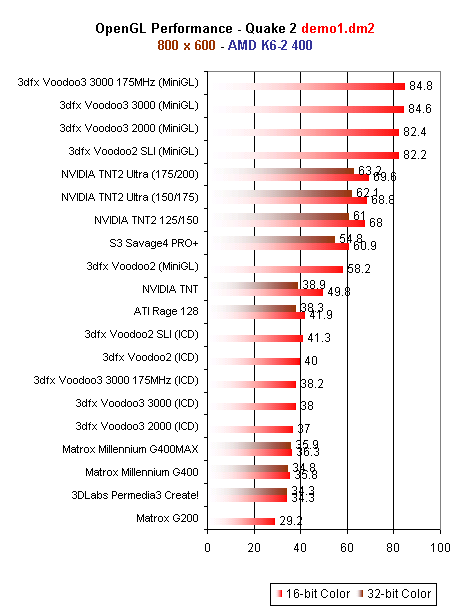
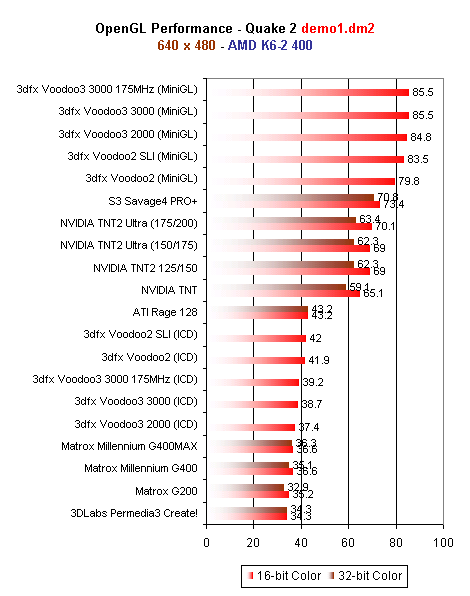
With the CPU power at its lowest, the K6-2 300 tests easily separate the CPU dependent from the CPU appreciative accelerators out there.
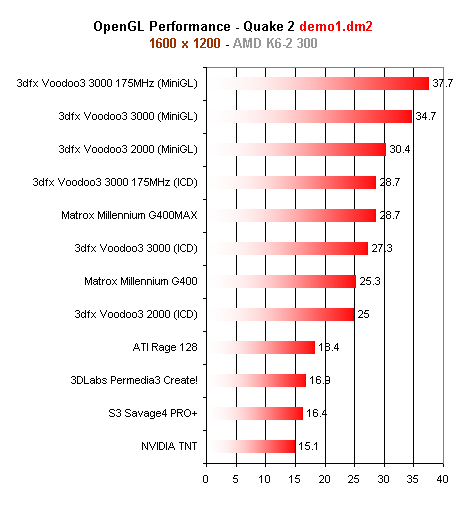
With relatively little competition from the older generation cards, it's no surprise that the top performers are still 3dfx/NVIDIA parts, even at this slower clock speed.
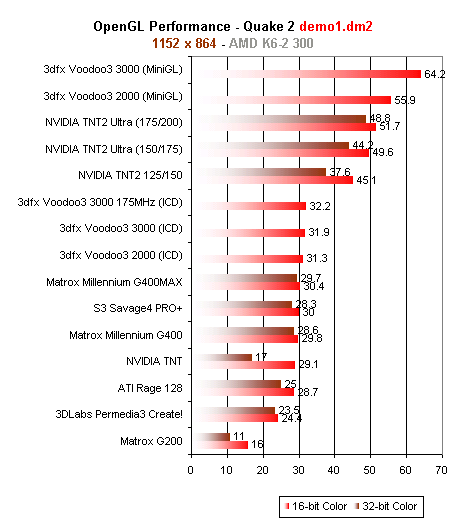
Two unexpected decent performers make themselves known here, the Voodoo2 SLI armed with its MiniGL does some damage to NVIDIA's TNT2 Ultra which is a tad more CPU dependent than most K6-2 300 users would like (however keep in mind that CPU dependent also means that it scales well with processors. Translation? If you upgrade your processor, you get noticeably more performance). The second item worth noting is the Savage4, although it doesn't compete with the TNT2 Ultra or Voodoo3 (MiniGL) it does separate itself from the rest of the elderly pack by a good margin.
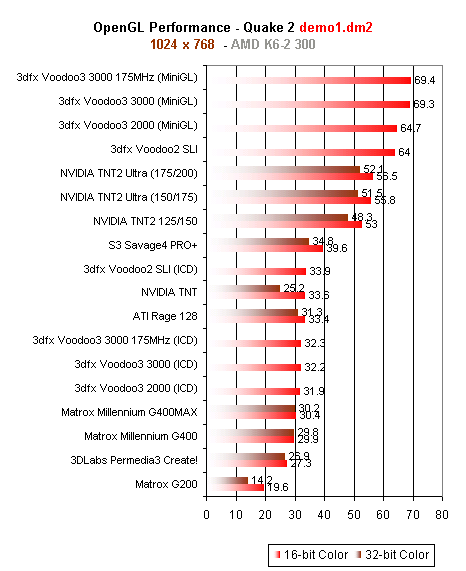
3dfx holds a nice lead at 800 x 600, however if you take away the MiniGL or prefer 32-bit color rendering, your next best option is, of course, the TNT2 Ultra. Interestingly enough, separating the overclocked TNT2 Ultra at 175MHz and the regular TNT2 Ultra at 150MHz is the Savage4 PRO+. It's amazing what updated drivers can do for a card, if you don't plan upgrading your CPU in the near future, and are looking for decent performance on a system such as this one, then the Savage4 isn't such a bad idea anymore. It even supports 32-bit color rendering, not bad at all. It's not the best accelerator, but it does have its moments.
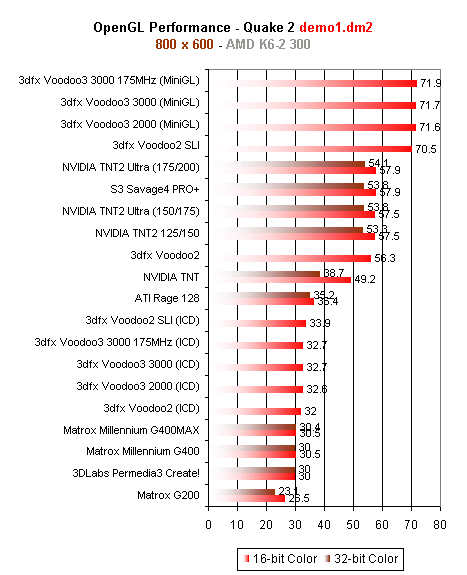
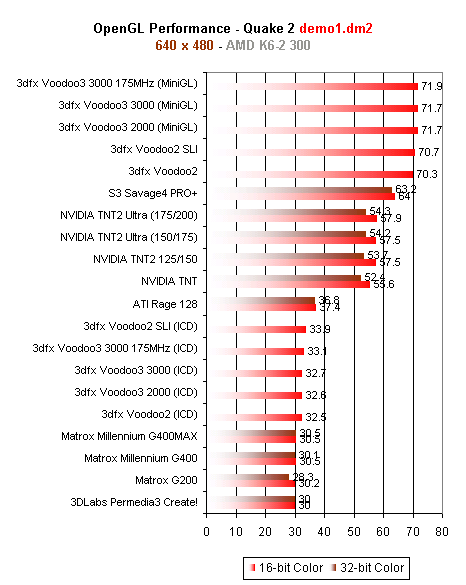
When looking at crusher.dm2 scores, you must keep two things in mind:
1) These scores represent the absolute worst case scenario for your system, you don't necessarily want the highest crusher.dm2 score, but rather the best range of scores, with the crusher.dm2 as your lowest and demo1.dm2 as your highest. That will give you a fairly accurate representation of what real world gaming performance will give you on your particular card/system combination.
2) The crusher.dm2 test is very CPU dependent which also means that you may gain more benefit from a faster CPU than a faster graphics card. This is a point of reevaluation for owners of video cards that were the top of the line last year, such as TNTs, Voodoo2s, etc... you may be better off investing in a more powerful CPU.
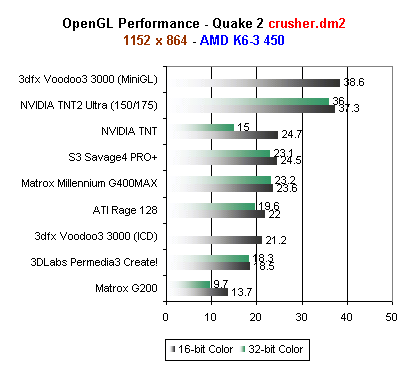
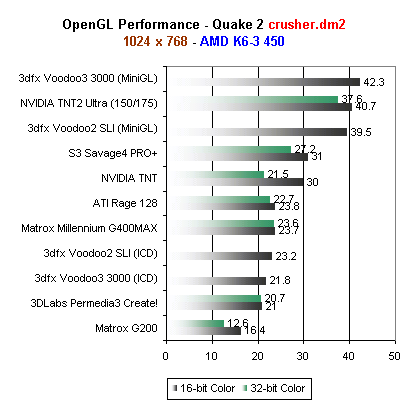
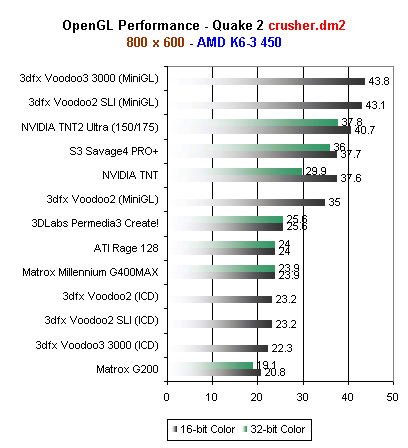
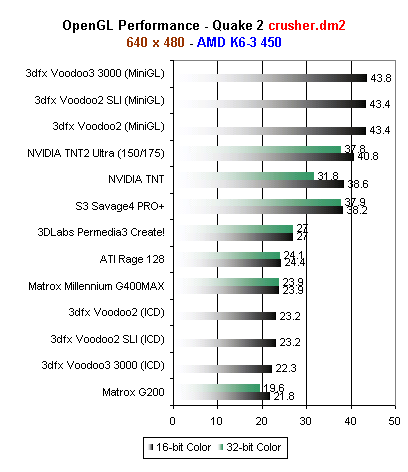
The TNT2 Ultra is by far the strongest crusher performer at such a high resolution, an excellent implementation of the AGP 2X specification as well as a well made OpenGL ICD keep the TNT2 Ultra ahead of the pack at such a high resolution. Bringing 1600 x 1200 down to a tolerable level to play at, provided that you have a fast enough CPU.
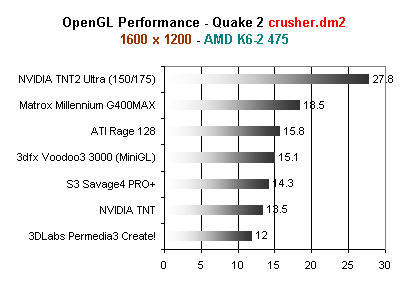
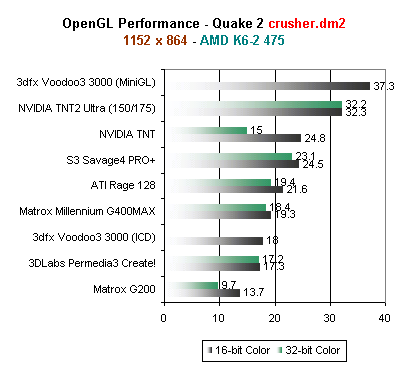
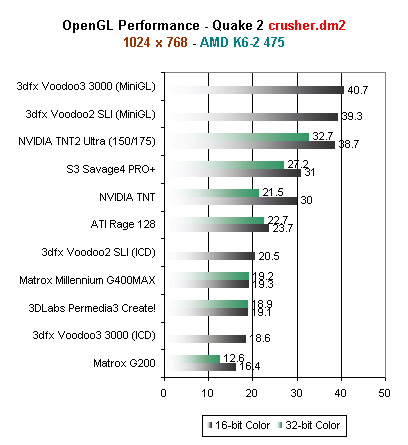
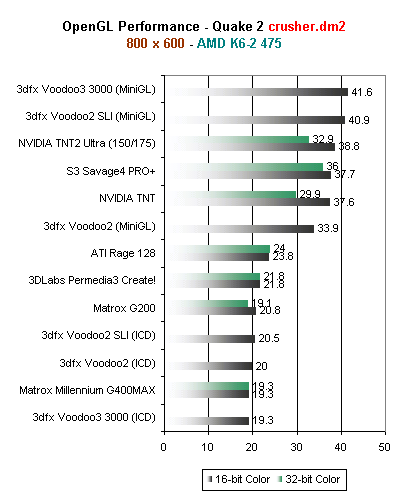
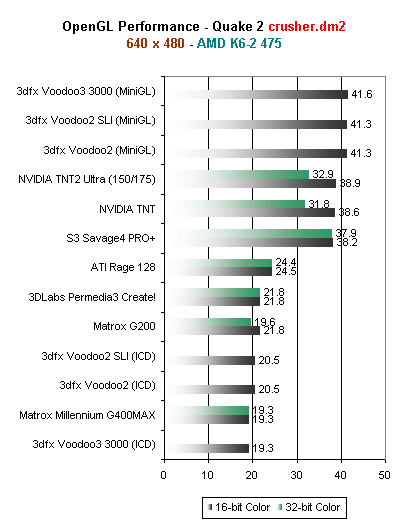
The standings stay pretty much constant through the different CPU speeds, with a few place exchanges here and there.
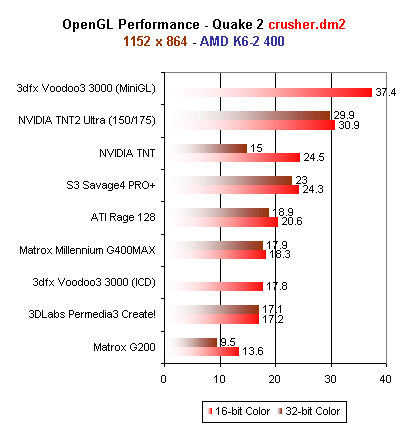
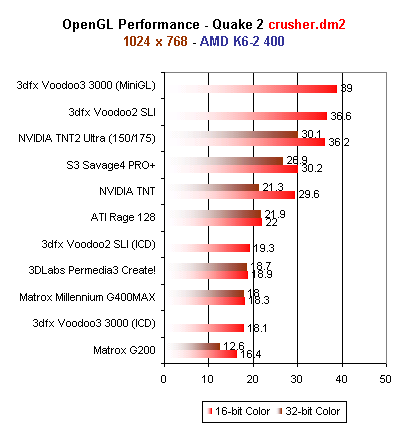
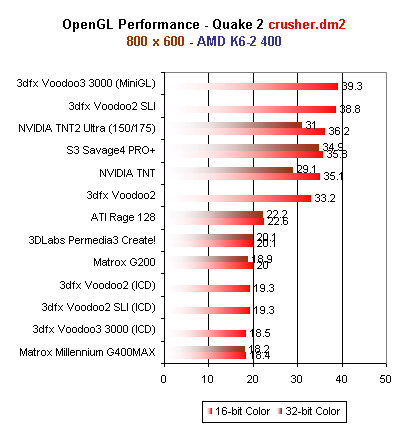
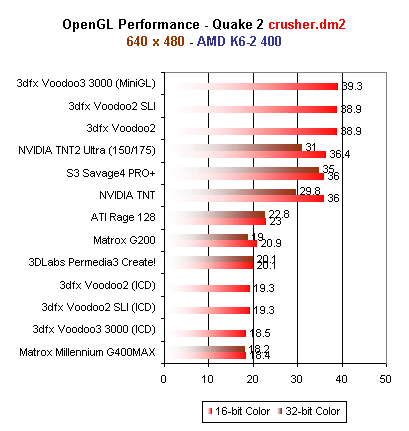
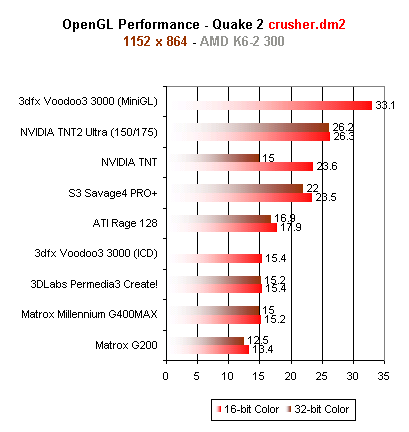
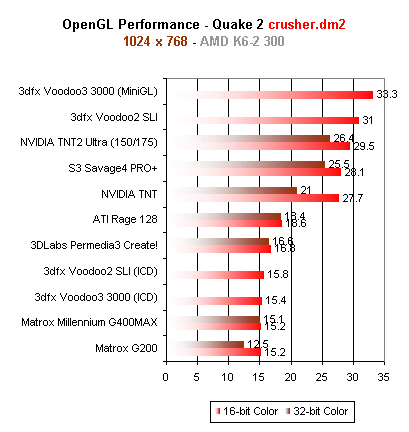
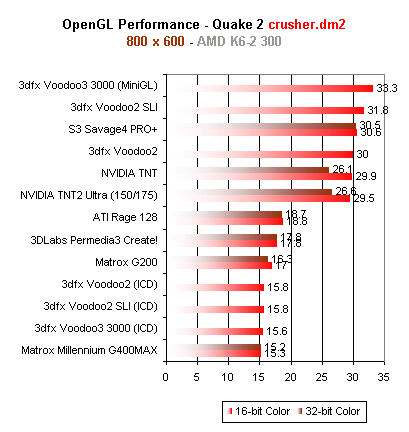
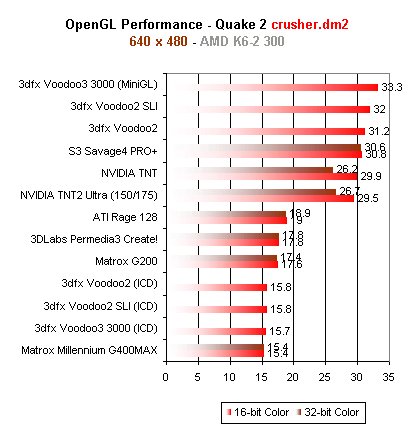
Direct3D Performance
For months now, there hasn't been a decent Direct3D game that could measure performance accurately. Shogo is probably one of the worst benchmarks ever used on AnandTech as a Direct3D benchmark, however it was the best/only option for quite some time. At the same time, Incoming/Forsaken were quickly growing to be beyond highly outdated benchmarks, luckily Rage Software, the makers of Incoming, included a nice benchmark in their latest release, Expendable (which is a pretty cool game actually). Unfortunately Expendable is very CPU dependent and isn't the best way of comparing one card to another, nevertheless it is the best thing to benchmark Direct3D with currently, so we'll have to use it. The game to keep an eye out for is Unreal Tournament, if Epic includes a decent benchmark in UT, you can expect that to become the next Direct3D game used for benchmarking.
To run the Expendable benchmark, simply run the go.exe file with the '-timedemo' extension, i.e. C:\Expendable\go.exe -timedemo. All Expendable benchmarks were performed with bumpmapping turned off, and texture detail set to high. The performance illustrated by the Expendable demo did not vary greatly between 16-bit and 32-bit color, making the results redundant, and therefore only 16-bit color tests were shown. At the same time, the performance drop vs resolution increase was negligible, making 1024 x 768 - 16 bit color the only performance represented.
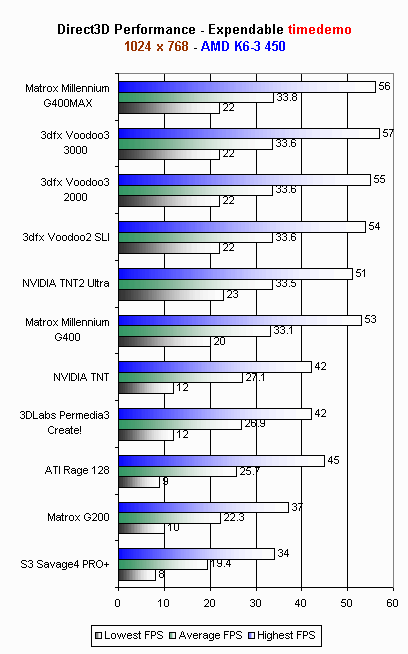
Expendable provides a nice method of judging performance in spite of its incredible CPU dependency. Every benchmark is outputted with a highest, lowest, and average FPS score. Therefore, a single set of Expendable benchmarks can provide you with the same information, albeit for Direct3D, as demo1.dm2 and crusher.dm2 would for Quake 2 (in OpenGL).
The results pretty much indicate that the G400MAX is the fastest Direct3D performer out of the bunch, followed by the 3dfx and NVIDIA contributors with a close second. You'll start to notice a larger drop in performance as you proceed from the Millennium G400 (regular) down to the Savage4 PRO+. Keep in mind that a difference of a few FPS in Expendable translates into a much larger real world performance drop.
Conclusion
The bigger picture grows clearer as last year's dominating performers are added to the comparison, however all this talk about driver quality, OpenGL ICDs, and MiniGL drivers isn't all that relevant to your average gamer. But what happens when you combine a Super7 system, with a professional by day, and a gamer by night? Let's just say that the Voodoo3 won't reign king in that environment for too long.







